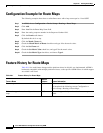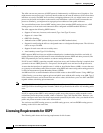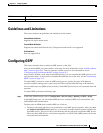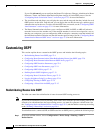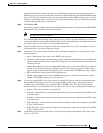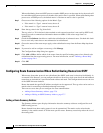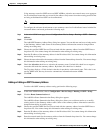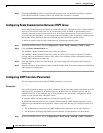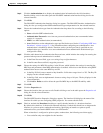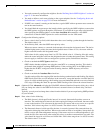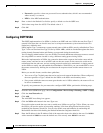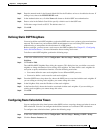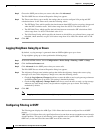
27-8
Cisco ASA 5500 Series Configuration Guide using ASDM
Chapter 27 Configuring OSPF
Customizing OSPF
Step 6 Check the Advertise check box to advertise the summary route. Uncheck this check box to suppress
routes that fall under the summary address. By default, this check box is checked.
Configuring Route Summarization Between OSPF Areas
Route summarization is the consolidation of advertised addresses. This feature causes a single summary
route to be advertised to other areas by an area boundary router. In OSPF, an area boundary router
advertises networks in one area into another area. If the network numbers in an area are assigned in a
way so that they are contiguous, you can configure the area boundary router to advertise a summary route
that includes all the individual networks within the area that fall into the specified range.
To define an address range for route summarization, perform the following steps:
Step 1 In the main ASDM window, choose Configuration > Device Setup > Routing > OSPF > Setup.
Step 2 Click the Route Summarization tab.
The Add/Edit a Route Summarization Entry dialog box appears.
The Add/Edit a Route Summarization Entry dialog box allows you to add new entries to or modify
existing entries in the Summary Address table. Some of the summary address information cannot be
changed when editing an existing entry.
Step 3 Enter the OSPF Area ID in the Area ID field. You cannot change this information when editing an
existing entry.
Step 4 Enter the IP address of the summary address in the IP Address field. You cannot change this information
when editing an existing entry.
Configuring OSPF Interface Parameters
You can change some interface-specific OSPF parameters, if necessary.
Prerequisites
You are not required to change any of these parameters, but the following interface parameters must be
consistent across all routers in an attached network: the Hello interval, the Dead interval, and the
Authentication key. If you configure any of these parameters, be sure that the configurations for all
routers on your network have compatible values.
To configure OSPF interface parameters, perform the following steps:
In ASDM, the Interface pane lets you configure interface-specific OSPF routing properties, such as
OSPF message authentication and properties. There are two tabs that help you configure interfaces in
OSPF:
• The Authentication tab displays the OSPF authentication information for the ASA interfaces.
• The Properties tab displays the OSPF properties defined for each interface in a table format.
Step 1 In the main ASDM window, choose Configuration > Device Setup > Routing > OSPF > Interface.



